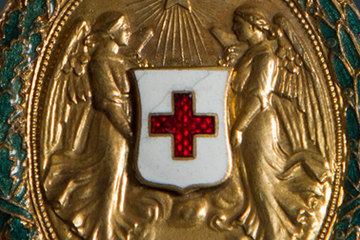With the outbreak of war and male conscription, many women suddenly had to fend for themselves. Now they were responsible for the survival of the family, which, given dwindling food supplies, was becoming a more difficult task with each passing day.
The pain of parting and the fear for the husbands, sons and fathers who had been called up were often accompanied by feelings of pride and war euphoria. Images of excited, cheering women saying goodbye to their nearest and dearest at the railway station continue to define our impression of the mood at the outbreak of war.
This excitement was, however, soon overshadowed by the hardships of everyday life at home. To prevent economic collapse, conscripted men had to be replaced by female workers. This was compounded by catastrophic problems with food provision, which required skilful and strategic management of the available resources. Queuing for hours in front of grocery shops was as much a part of everyday life as illegal food purchases on the black market, or what were known as ‘hamster trips’ to the countryside, where it was possible to acquire some eggs, dripping or potatoes in exchange for jewellery or tobacco, for example. From 1915, there was food rationing through distribution stamps. Neither the food stamps that had been handed out nor the allowance paid to soldiers’ wives by the state made it possible to make ends meet, though.
The cost of living had already doubled in the first year of the war. Thrifty housekeeping and the clever use of ersatz foods not only ensured people’s own existences, but also safeguarded the functioning of the war economy. The household thus became an ‘economic trench’: the scene of an day-to-day battle for survival.
Women had to adapt their household management to the war situation. Various women’s organizations, including the Reichsorganisation der Hausfrauen Österreichs [Organization of Austrian Housewives] and Frauenhilfsaktion im Kriege [Women’s War Assistance] organized lectures on food procurement, published war recipes, and taught women how to make use of ersatz ingredients like swedes and saccharine. They advocated state price controls for food and harsher penalties for salespeople who intentionally inflated prices. The focus was not only on providing help, but also on mobilizing women and their contribution to the war.
It should already be evident that the women being discussed here do not constitute a homogenous group with identical experiences. While some were struggling to survive or even downright begging for food, others attempted to take advantage of the suffering around them. No small number of women were arrested for black market trading and price-fixing, and a remarkable number of women were involved in physical confrontations at markets. The image of the loving, caring mother associated with the home(land) soon began to buckle under the stress of difficult wartime living conditions.
Translation: Aimee Linekar
Bauer, Ingrid: Frauen im Krieg. Patriotismus, Hunger, Protest – weibliche Lebenszusammenhänge zwischen 1914 und 1918, in: Mazohl-Wallnig, Brigitte (Hg.): Die andere Geschichte 1. Eine Salzburger Frauengeschichte von der ersten Mädchenschule (1695) bis zum Frauenwahlrecht (1918), Salzburg 1995, 285-310
Daniel, Ute: Frauen, in: Hirschfeld, Gerhard/Krumeich, Gerd/Renz, Irina (Hrsg.): Enzyklopädie Erster Weltkrieg, Paderborn et al. 2009, 116-134
Healy, Maureen: Vienna and the Fall of the Habsburg Empire. Total War and Everyday Life in World War I, Cambridge 2004
Heeresgeschichtliches Museum: Die Frau im Krieg. Katalog zur Ausstellung vom 6. Mai bis 26. Oktober 1986, Wien 1986
Zitate:
"economic trench": Bauer, Ingrid: Frauen im Krieg. Patriotismus, Hunger, Protest – weibliche Lebenszusammenhänge zwischen 1914 und 1918, in: Mazohl-Wallnig, Brigitte (Hg.): Die andere Geschichte 1. Eine Salzburger Frauengeschichte von der ersten Mädchenschule (1695) bis zum Frauenwahlrecht (1918), Salzburg 1995, 305 (Translation)













